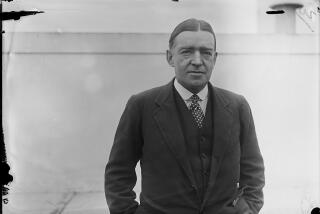Did Robert Falcon Scott Tell the Truth?
- Share via
Soundly beaten in a race to the South Pole, British explorer Robert Falcon Scott and his companions froze to death in 1912 as they struggled homeward. Scott’s moving account of the expedition’s final days trapped in a tent by a blizzard only miles from safety, as recorded in his diary and last letters, has stirred generations of armchair explorers.
“Every day we have been ready to start for our depot 11 miles away, but outside the door of the tent it remains a scene of whirling drift,” Scott wrote in the expedition diary later found with his body. Trapped in their tent for 10 days without food or fuel, they helplessly wasted away. In a dying coda to his public he scrawled, “these rough notes and our dead bodies must tell the tale....”
But is that tale of the fatal “frightful storm” true? The final tragic chapter of his expedition may have been quite different from the account that the dying Scott left behind. There may have been no blizzard, no reason to halt their march save Scott’s own infirmities. His two companions may have chosen to die rather than to continue without him.
All that science has learned of Antarctic meteorology in the 90 years since Scott’s expedition suggests that the killing storm might never have happened.
That informed conjecture is one provocative element in Susan Solomon’s “The Coldest March: Scott’s Fatal Antarctic Expedition” and raises the possibility that Scott and his men, humiliated by loss to the Norwegian Roald Amundsen in their famous race to the Pole, committed suicide. Solomon, an atmospheric scientist at the National Oceanic and Atmospheric Administration in Boulder, Colo., meticulously documents how unusually bad weather through most of their journey actually did compound mistakes by Scott and his team at every turn, erasing their all-too-narrow margin of safety. Her judgments are buttressed by careful study of expedition weather records and atmospheric circulation patterns at the end of the world. Her theory--that the final storm never took place--is her most surprising conclusion.
Unlike storms elsewhere on the planet, the gales of Antarctica are flashfloods of air from vast reservoirs of frigid air pooled over the center of the continent. Heavy with cold, these howling air currents fall in predictable patterns down the slope of the polar plateau. When the reservoir is drained, such storms die. Not even the fiercest blizzard can last more than two or three days, modern records show. A blizzard lasting 10 days simply does not fit the pattern of Antarctica’s storm systems, as documented in readings at more than 50 automated weather stations over the last 15 years.
Moreover, detailed weather readings taken in March 1912 by men stationed downwind 100 miles from the spot where Scott and his men were supposedly trapped--squarely in the path of any storm--show not the slightest trace of a blizzard, only a light breeze and relatively warm temperatures. Under such conditions, Solomon writes, the short trek to vital supplies cached at a nearby depot “would have been almost effortless.”
So how do we explain the catastrophe? Suicide is at least plausible. One injured expedition member, Lawrence Oates, crippled by frostbite, intentionally left the safety of the tent so he would not hold back the others. “I am just going outside and may be some time,” he said, then disappeared forever into the blowing snow in the perfect understated, post-Victorian gesture of sacrifice. No one stopped him. Another expedition member, Edgar Evans, died of injuries on the return trek.
Scott did issue 30 opium pills, “the means of ending our troubles,” to each of his surviving companions, Edward Wilson and H.R. Bowers. But there is no way to know if any of the men took the pills or whether they all stoically succumbed to cold and starvation.
The expedition’s last words are Scott’s alone. Perhaps he wrote the truth; perhaps he sought to preserve some vestige of dignity and privacy; perhaps he orchestrated an uplifting ending to his adventure for the public that funded his work. Both Wilson and Bowers wrote letters to family and friends at every opportunity throughout the trek, but neither chose to say anything about why they stayed in the tent for the last week of their lives. For Solomon, their silence is rather curious and perhaps the most haunting evidence that the 10-day storm never existed.
“Wilson and Bowers met their deaths with the injured Scott, but the scientific constraints of modern meteorology as shown here suggest that their deaths may have been a matter of choice rather than chance,” Solomon writes. “Whether such a choice was made, and whether it reflected their own dedication or an order by a desperate Scott vainly trying to save legacies rather than lives is a question not for science but for the human heart.”
When Scott and his men froze to death, it broke an empire’s heart. Indeed, Scott’s failed expedition was a blow to national pride on a par with the wreck of the Titanic, which sank a few months before news of Scott’s fate reached England. Ninety years later, Scott’s second-place finish still rankles.
In recent decades, Scott’s reputation as an expert explorer has taken a beating from historians. No Antarctic explorer led more men to their deaths. By any measure, Scott was vain, ambitious, jealous, dangerously impulsive, depressive and self-pitying. He was capable of surprising cruelty to the men who served him most loyally. He embodied all the aristocratic prejudices of the British officer class.
His inattention to detail during the expedition often had calamitous results. Skis were thrown away. Motorized tractors fell through the ice or broke down. The ponies foundered. Dogs were unmanageable because no one was properly trained in their use. Food for men and pack animals was inadequate for such arduous work. Last-minute detours and changes in personnel jeopardized the expedition’s safety.
In contrast, Amundsen, perhaps the most practiced polar explorer of his generation, beat Scott to the Pole by a month. Well-trained, well-equipped and well-fed, his expedition skied the 900 miles across Antarctica’s frozen wasteland to the Pole with surprising ease and grace. Nothing distracted him from his single purpose, no detail of planning or equipment escaped his sustained attention.
Unlike Amundsen, however, Scott stocked his crew with scientists. He acted in the same British naval tradition of exploration that also caused a young Charles Darwin to be hired as a naturalist for the voyage of the Beagle. Among his 65 men, Scott brought to Antarctica botanists, biologists, meteorologists and people schooled in planetary physics.
For all its other failings, his was a spirit open to experiment, even if it meant that at crucial junctures he strayed from the strict discipline of polar survival. Rarely has failure so outshone success. In his untutored enthusiasm for polar research, Scott laid the foundations of modern Antarctica: a continent without borders, passports or police where science reigns supreme.
Whatever the truth of their last days, however, Solomon contends that bad weather, not Scott’s bad judgment, incompetence or miscalculation, caused the expedition’s disaster. By leaving so much earlier in the season than Scott, Amundsen never encountered such unusual conditions.
Climate experts have determined that Antarctic weather seems to swing from one extreme to another in a four-year cycle, not unlike the El Nino cycle that has such a profound effect on weather in more temperate climes. Scott’s expedition encountered that cycle at its most severe, Solomon said. In 1911, it took Scott’s ship three weeks to clear the pack ice that girdles Antarctica and make landfall. Amundsen sailed through it in three days. Explorer Sir Ernest Shackleton cleared it in two days three years before.
While other historians have dismissed Scott’s complaints about the extreme weather, discounting as well the accuracy of the expedition’s temperature records, Solomon and her colleagues compared temperatures from automated weather stations along Scott’s route with those readings, which were taken three times a day all through the trip. Scott’s readings on his way to the Pole were almost identical to the current average temperature there, about 22 degrees below zero. In the crucial three weeks of his homeward journey, the weather along his path was 20 degrees lower than normal for the time of year.
Solomon indirectly confirms the accuracy of the expedition thermometers and suggests the very low temperatures they recorded on their homeward trip were correct. At 40 degrees below zero, the snow surface was so cold that the sledges Scott and his men hauled could not slide properly. Precious stores of fuel evaporated. Rations more than adequate at sea level were not enough to stave off starvation at high altitude. All the devastating biophysical effects of altitude, dehydration, malnutrition and emotional fatigue were worsened. Severe frostbite was inevitable.
In this, Solomon confirms Scott’s own explanation for his failure up until the moment of the controversial storm. “No one in the world would have expected the temperatures and surfaces which we encountered at this time of year,” Scott wrote in his last message to the public. “It is clear that these circumstances came on very suddenly, and our wreck is certainly due to this sudden advent of severe weather.”
Ninety years later, the death of Scott and the loss of his expedition remain among the great enigmas of the 20th century. Hero or fool, he is today less a mortal man than a clear reflection of our ambivalence toward ambitions that proceed at any cost. “The Coldest March” captures that legacy in the full meridian of its glory.
*
Robert Lee Hotz is a science writer for The Times. He has traveled three times to the South Pole to report on research activities there.
More to Read
Sign up for Essential California
The most important California stories and recommendations in your inbox every morning.
You may occasionally receive promotional content from the Los Angeles Times.













